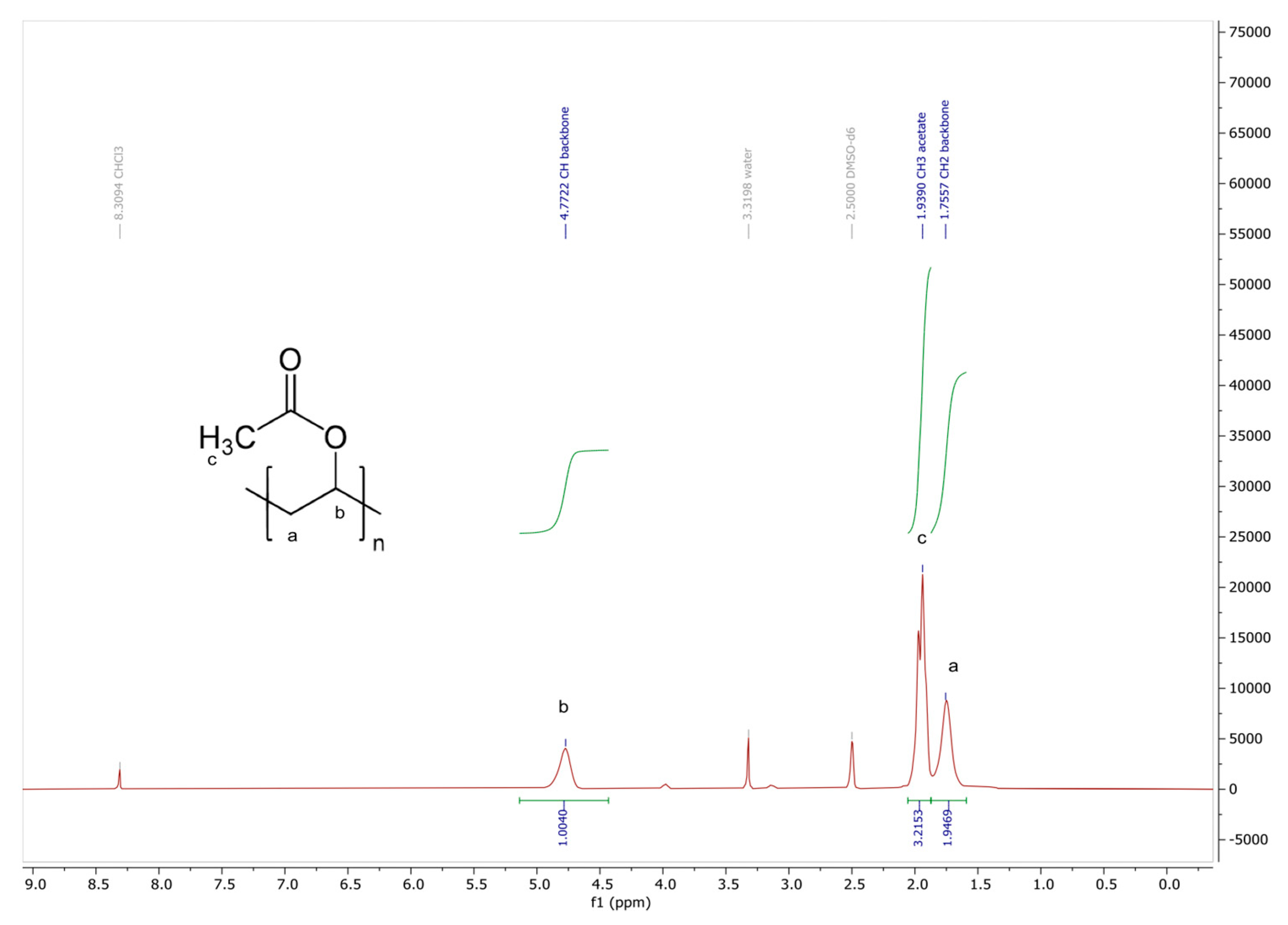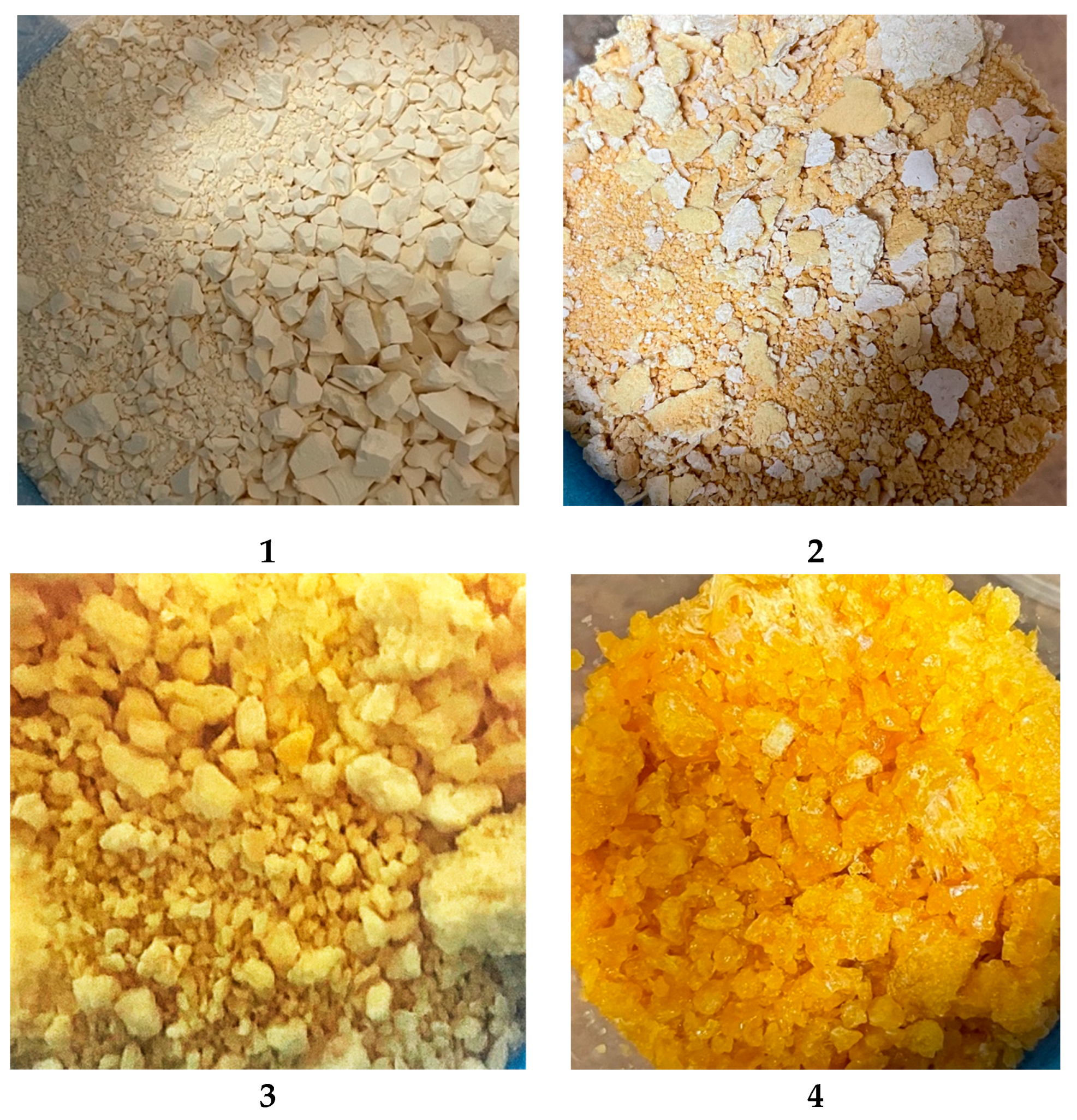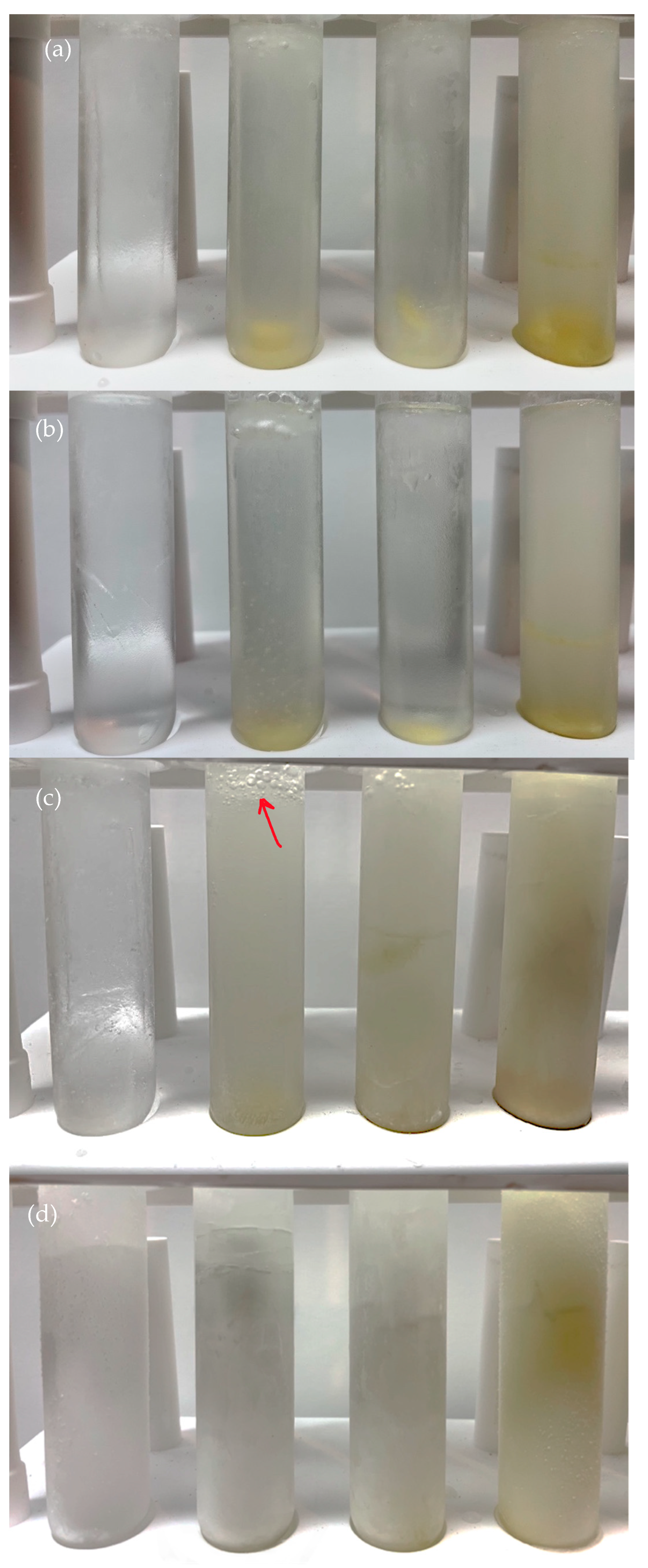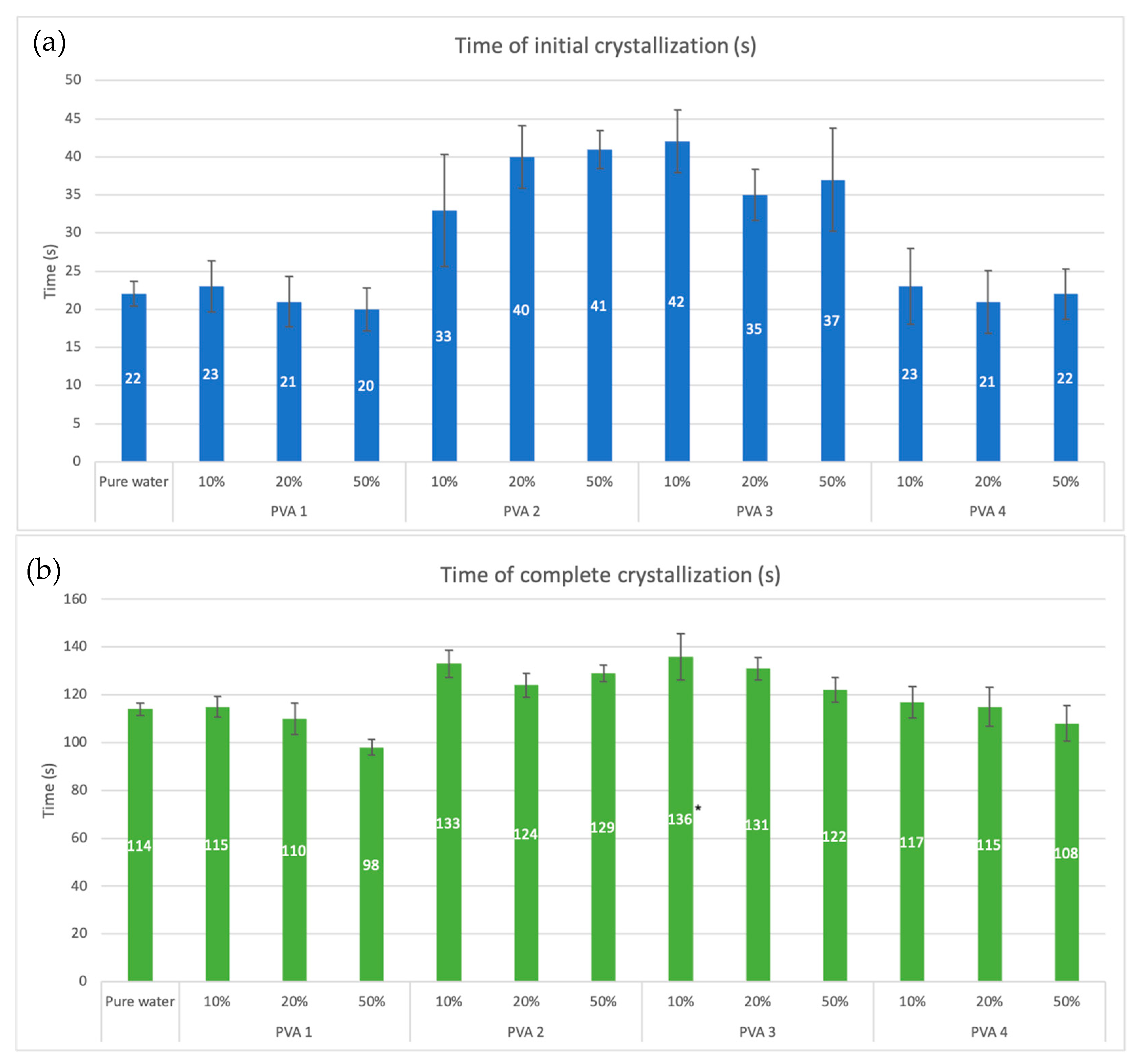The Modification of Polyvinyl Alcohol for Ice Nucleation Based upon the Structures of Antifreeze Glycoproteins Found in Antarctic Fish
Abstract
1. Introduction
2. Materials and Methods
2.1. Polyvinyl Alcohol
2.1.1. Synthesis of Poly(vinyl acetate)
2.1.2. Synthesis of Poly(vinyl) Alcohol
2.2. Ice Inhibition Experiments
3. Results and Discussion
4. Conclusions
Funding
Data Availability Statement
Conflicts of Interest
References
- Wisniewski, M.; Willick, I.R.; Duman, J.G.; Livingston, D.; Newton, S.S. Plant antifreeze proteins. In Antifreeze Proteins; Springer: Cham, Switzerland, 2020; Volume 1, pp. 189–226. [Google Scholar]
- Nagel, L.; Plattner, C.; Budke, C.; Majer, Z.; Devries, A.L.; Berkemeier, T.; Koop, T.; Sewald, N. Synthesis and characterization of natural and modified antifreeze glycopeptides: Glycosylated foldamers. Amino Acids 2011, 41, 719–732. [Google Scholar] [CrossRef] [PubMed]
- Bagwell, S.N.; Ricker, J.V. Antifreeze proteins: Effective adaptations of organisms for low temperature survival. Bios 2019, 90, 158–170. [Google Scholar] [CrossRef]
- Duman, J.G.; Samuel, S. Newton. Insect Antifreeze Proteins. In Antifreeze Proteins; Springer: Cham, Switzerland, 2020; Volume 1, pp. 131–187. [Google Scholar]
- Voets, I.I. From ice-binding proteins to bio-inspired antifreeze materials. Soft Matter 2017, 13, 4808–4823. [Google Scholar] [CrossRef] [PubMed]
- Wierzbicki, A.; Taylor, M.S.; Knight, C.A.; Madura, J.D.; Harrington, J.P.; Sikes, C.S. Analysis of shorthorn sculpin antifreeze protein stereospecific binding to (2–10) faces of ice. Biophys. J. 1996, 71, 8–18. [Google Scholar] [CrossRef]
- Devries, A.L. Glycoproteins as Biological Antifreeze Agents in Antarctic Fishes. Science 1971, 172, 1152–1155. [Google Scholar] [CrossRef]
- Knight, C.; Driggers, E.; Devries, A. Adsorption to ice of fish antifreeze glycopeptides 7 and 8. Biophys. J. 1993, 64, 252–259. [Google Scholar] [CrossRef]
- Harding, M.M.; Anderberg, P.I.; Haymet, A.D.J. ’Antifreeze’ glycoproteins from polar fish. JBIC J. Biol. Inorg. Chem. 2003, 270, 1381–1392. [Google Scholar] [CrossRef]
- Geoghegan, K.; Osuga, D.; Ahmed, A.; Yeh, Y.; Feeney, R. Antifreeze glycoproteins from Polar fish. Structural requirements for function of glycopeptide 8. J. Biol. Chem. 1980, 255, 663–667. [Google Scholar] [CrossRef]
- Liu, S.; Ben, R.N. C-linked galactosyl serine AFGP analogues as potent recrystallization inhibitors. Org. Lett. 2005, 7, 2385–2388. [Google Scholar] [CrossRef]
- Urbańczyk, M.; Góra, J.; Latajka, R.; Sewald, N. Antifreeze glycopeptides: From structure and activity studies to current approaches in chemical synthesis. Amino Acids 2016, 49, 209–222. [Google Scholar] [CrossRef]
- Meister, K.; Devries, A.L.; Bakker, H.J.; Drori, R. Antifreeze Glycoproteins Bind Irreversibly to Ice. J. Am. Chem. Soc. 2018, 140, 9365–9368. [Google Scholar] [CrossRef] [PubMed]
- Mochizuki, K.; Molinero, V. Antifreeze Glycoproteins Bind Reversibly to Ice via Hydrophobic Groups. J. Am. Chem. Soc. 2018, 140, 4803–4811. [Google Scholar] [CrossRef] [PubMed]
- Meister, K.; Moll, C.J.; Chakraborty, S.; Jana, B.; Devries, A.L.; Ramløv, H.; Bakker, H.J. Molecular structure of a hyperactive antifreeze protein adsorbed to ice. J. Chem. Phys. 2019, 150, 131101. [Google Scholar] [CrossRef] [PubMed]
- Surís-Valls, R.; Voets, I.K. Peptidic antifreeze materials: Prospects and challenges. Int. J. Mol. Sci. 2019, 20, 5149. [Google Scholar] [CrossRef] [PubMed]
- Weng, L.; Stott, S.L.; Toner, M. Molecular dynamics at the interface between ice and poly (vinyl alcohol) and ice recrystallization inhibition. Langmuir 2017, 34, 5116–5123. [Google Scholar] [CrossRef] [PubMed]
- Tessier, S.N.; Haque, O.; Pendexter, C.A.; Cronin, S.E.; Weng, L.; Yeh, H.; Markmann, J.F.; Taylor, M.J.; Fahy, G.M.; Toner, M.; et al. The role of antifreeze glycopeptides (AFGP) and polyvinyl alcohol/polyglycerol (X/Z-1000) cocktails as ice modulators during partial freezing of rat livers. bioRxiv 2021, in press. [Google Scholar]
- Sheng, W.; Li, X.; Pei, Y.; Wang, R.; Zhang, X.; Pang, S. Mechanism of ice nucleation inhibition of PVA and PVP in aqueous glycerin solution. Thermochim. Acta 2020, 689, 178617. [Google Scholar] [CrossRef]
- Liu, X.; Pan, Y.; Liu, F.; He, Y.; Zhu, Q.; Liu, Z.; Zhan, X.; Tan, S. A review of the material characteristics, antifreeze mechanisms, and applications of cryoprotectants (CPAs). J. Nanomater. 2021, 2021, 9990709. [Google Scholar] [CrossRef]
- Fitzner, M.; Philipp, P.; Michaelides, A. Predicting heterogeneous ice nucleation with a data-driven approach. Nat. Commun. 2020, 11, 4777. [Google Scholar] [CrossRef]
- Bleszynski, M.; Reil, M.; Kumosa, M. Hydroxyl Group Separation Distances in Anti-Freeze Compounds and Their Effects on Ice Nucleation. Int. J. Mol. Sci. 2020, 21, 8488. [Google Scholar] [CrossRef]
- Bleszynski, M.; Reil, M. Computational Assessment of Modified Antifreeze Glycoproteins on Ice Nucleation. Biophysica 2021, 1, 168–178. [Google Scholar] [CrossRef]
- Chang, T.; Gang, Z. Ice inhibition for cryopreservation: Materials, strategies, and challenges. Adv. Sci. 2021, 8, 2002425. [Google Scholar] [CrossRef] [PubMed]
- Deller, R.C.; Pessin, J.E.; Vatish, M.; Mitchell, D.A.; Gibson, M.I. Enhanced non-vitreous cryopreservation of immortalized and primary cells by ice-growth inhibiting polymers. Biomater. Sci. 2016, 4, 1079–1084. [Google Scholar] [CrossRef] [PubMed]
- Sabando, C.; Ide, W.; Rodríguez-Llamazares, S.; Bastías, R.M.; Valenzuela, M.; Rojas, C.; Castaño, J.; Pettinelli, N.; Bouza, R.; Müller, N. Preparation of Poly (vinyl Alcohol) Microparticles for Freeze Protection of Sensitive Fruit Crops. Polymers 2022, 14, 2452. [Google Scholar] [CrossRef] [PubMed]
- Sabando, C.; Ide, W.; Rodríguez-Llamazares, S.; Bastías, R.M.; Valenzuela, M.; Rojas, C.; Castaño, J.; Pettinelli, N.; Bouza, R.; Müller, N. Viscosity of deeply supercooled water and its coupling to molecular diffusion. Proc. Natl. Acad. Sci. USA 2015, 112, 12020–12025. [Google Scholar]
- Budiaman, E.R.; Fennema, O. Linear rate of water crystallization as influenced by viscosity of hydrocolloid suspensions. J. Dairy Sci. 1987, 70, 547–554. [Google Scholar] [CrossRef]
- Röttger, K.; Endriss, A.; Ihringer, J.; Doyle, S.; Kuhs, W.F. Lattice constants and thermal expansion of H2O and D2O ice Ih between 10 and 265 K. Acta Crystallogr. Sect. B Struct. Sci. 1994, 50, 644–648. [Google Scholar] [CrossRef]
- Czechura, P.; Tam, R.Y.; Dimitrijevic, E.; Murphy, A.V.; Ben, R.N. The Importance of Hydration for Inhibiting Ice Recrystallization with C-Linked Antifreeze Glycoproteins. J. Am. Chem. Soc. 2008, 130, 2928–2929. [Google Scholar] [CrossRef]
- Nada, H.; Furukawa, Y. Antifreeze proteins: Computer simulation studies on the mechanism of ice growth inhibition. Polym. J. 2012, 44, 690–698. [Google Scholar] [CrossRef]
- Reinhardt, A.; Doye, J.P.K. Free energy landscapes for homogeneous nucleation of ice for a monatomic water model. J. Chem. Phys. 2012, 136, 054501. [Google Scholar] [CrossRef]
- Budke, C.; Dreyer, A.; Jaeger, J.; Gimpel, K.; Berkemeier, T.; Bonin, A.S.; Nagel, L.; Plattner, C.; Devries, A.L.; Sewald, N.; et al. Quantitative Efficacy Classification of Ice Recrystallization Inhibition Agents. Cryst. Growth Des. 2014, 14, 4285–4294. [Google Scholar] [CrossRef]




| Mw [kDa] | Mp [kDa] | Mn [kDa] | Đ | DP (Mw) | DP (Mn) | |
|---|---|---|---|---|---|---|
| PVAc | 7 | 7.2 | 2.8 | 2.5 | 81 | 33 |
| PVA Sample | DH [%] | PVA [%] | PVAc [%] | Final Amount [g] |
|---|---|---|---|---|
| 1 | 100 | 100 | 0 | 67 |
| 2 | 76 | 76 | 24 | 112 |
| 3 | 66 | 66 | 34 | 152 |
| 4 | 34 | 34 | 66 | 160 |
Publisher’s Note: MDPI stays neutral with regard to jurisdictional claims in published maps and institutional affiliations. |
© 2022 by the author. Licensee MDPI, Basel, Switzerland. This article is an open access article distributed under the terms and conditions of the Creative Commons Attribution (CC BY) license (https://creativecommons.org/licenses/by/4.0/).
Share and Cite
Bleszynski, M. The Modification of Polyvinyl Alcohol for Ice Nucleation Based upon the Structures of Antifreeze Glycoproteins Found in Antarctic Fish. Biophysica 2022, 2, 417-427. https://doi.org/10.3390/biophysica2040037
Bleszynski M. The Modification of Polyvinyl Alcohol for Ice Nucleation Based upon the Structures of Antifreeze Glycoproteins Found in Antarctic Fish. Biophysica. 2022; 2(4):417-427. https://doi.org/10.3390/biophysica2040037
Chicago/Turabian StyleBleszynski, Monika. 2022. "The Modification of Polyvinyl Alcohol for Ice Nucleation Based upon the Structures of Antifreeze Glycoproteins Found in Antarctic Fish" Biophysica 2, no. 4: 417-427. https://doi.org/10.3390/biophysica2040037
APA StyleBleszynski, M. (2022). The Modification of Polyvinyl Alcohol for Ice Nucleation Based upon the Structures of Antifreeze Glycoproteins Found in Antarctic Fish. Biophysica, 2(4), 417-427. https://doi.org/10.3390/biophysica2040037








